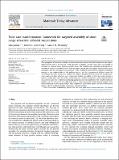| dc.contributor.author | Jamali, Safa | |
| dc.contributor.author | Armstrong, Robert C | |
| dc.contributor.author | McKinley, Gareth H | |
| dc.date.accessioned | 2021-10-27T20:04:55Z | |
| dc.date.available | 2021-10-27T20:04:55Z | |
| dc.date.issued | 2020 | |
| dc.identifier.uri | https://hdl.handle.net/1721.1/134418 | |
| dc.description.abstract | © 2019 The Authors The aggregation of attractive colloids has been extensively studied from both theoretical and experimental perspectives as the fraction of solid particles is changed, and the range, type, and strength of attractive or repulsive forces between particles varies. The resulting gels, consisting of disordered assemblies of attractive colloidal particles, have also been investigated with regards to percolation, phase separation, and the mechanical characteristics of the resulting fractal networks. Despite tremendous progress in our understanding of the gelation process, and the exploration of different routes for arresting the dynamics of attractive colloids, the complex interplay between convective transport processes and many-body effects in such systems has limited our ability to drive the system toward a specific configuration. Here, we study a model attractive colloidal system over a wide range of particle characteristics and flow conditions undergoing aggregation far from equilibrium. The complex multiscale dynamics of the system can be understood using a time-rate-transformation diagram adapted from understanding of materials processing in block copolymers, supercooled liquids, and much stiffer glassy metals to direct targeted assembly of attractive colloidal particles. | |
| dc.language.iso | en | |
| dc.publisher | Elsevier BV | |
| dc.relation.isversionof | 10.1016/J.MTADV.2019.100026 | |
| dc.rights | Creative Commons Attribution 4.0 International license | |
| dc.rights.uri | https://creativecommons.org/licenses/by/4.0/ | |
| dc.source | Elsevier | |
| dc.title | Time-rate-transformation framework for targeted assembly of short-range attractive colloidal suspensions | |
| dc.type | Article | |
| dc.contributor.department | Massachusetts Institute of Technology. Department of Chemical Engineering | |
| dc.contributor.department | MIT Energy Initiative | |
| dc.contributor.department | Hatsopoulos Microfluids Laboratory (Massachusetts Institute of Technology) | |
| dc.contributor.department | Massachusetts Institute of Technology. Department of Mechanical Engineering | |
| dc.relation.journal | Materials Today Advances | |
| dc.eprint.version | Final published version | |
| dc.type.uri | http://purl.org/eprint/type/JournalArticle | |
| eprint.status | http://purl.org/eprint/status/PeerReviewed | |
| dc.date.updated | 2020-07-31T13:52:33Z | |
| dspace.orderedauthors | Jamali, S; Armstrong, RC; McKinley, GH | |
| dspace.date.submission | 2020-07-31T13:52:35Z | |
| mit.journal.volume | 5 | |
| mit.license | PUBLISHER_CC | |
| mit.metadata.status | Authority Work and Publication Information Needed | |
